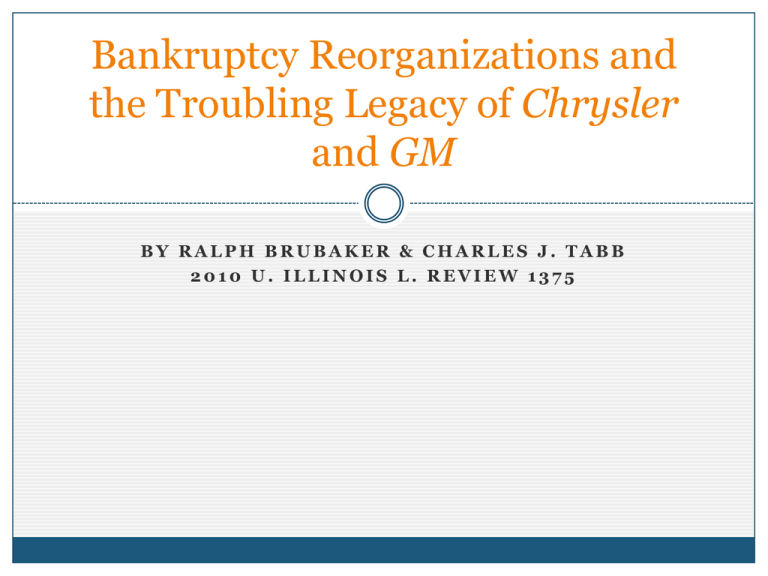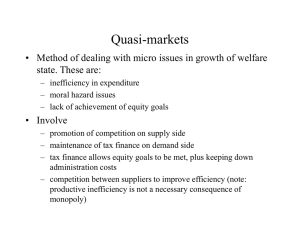Bankruptcy Reorganizations and the Troubling Legacy of
advertisement

Bankruptcy Reorganizations and
the Troubling Legacy of Chrysler
and GM
BY RALPH BRUBAKER & CHARLES J. TABB
2010 U. ILLINOIS L. REVIEW 1375
Or, “how scary is the § 363 revolution?”
§ 363
Or, “what is the essence of ‘reorganization’?”
“Reorganization” = ???
Sea change: Plan
363 sale
Chrysler & GM cases are the poster children
highlighting the sea change in recent years from the
traditional Chapter 11 reorganization model of a duly
confirmed “plan” to an all-asset sale under § 363
Plan
363
sale
The cases
Chrysler:
went through bankruptcy in 41 days
$2 billion “sale” from “Old Chrysler” to “New Chrysler” free &
clear of underwater senior secured debt
GM:
went through bankruptcy in 39 days
Credit bid “sale” from “Old GM” to “New GM,” to underwater
secured lenders
Traditional points of controversy re 363 sales
1st: all-asset sale under 363, rather than via plan,
deprives economic stakeholders of procedural &
substantive protections in plan process
2nd: not really a “sale” at all
But a “reorganization” wolf
masquerading in “sale”
sheep’s clothing
“Sub Rosa” plan
Historic “tests” to ferret out the twin concerns
The “sales are suspect” issue:
“good
business reason” (Lionel)
i.e., why can’t we wait for a plan?
The reorganization wolf / sales sheep issue:
No
“sub rosa plans” in a sale (Braniff)
What is not the problem
Neither the “sales are suspect” nor the “wolf/sheep sub
rosa” issue is real concern raised by auto cases
Although the “sub rosa” plan issue, properly understood, is
implicated
Problem: the “plan” / “sale” dichotomy is a false one
almost any sale can be effectuated as a plan, and any plan
can be structured as a sale
So not helpful for a court to seek guidance on whether to approve a
363 sale in a model of a “true” sale or plan – no such thing!
What is the problem
So what is our worry?
Boyd risen from the dead
Boyd
* referring of course to the 1913
Supreme Court ruling in equity receivership case
that any “value” in the debtor had to be distributed
in accordance with distributional entitlements,
notwithstanding a supposed “sale” structure
And yet this is precisely what the auto cases – and
especially GM – appear to allow
Boyd resurrected – and no one noticed
It is bad enough that the reorganization fallacy that
the Supreme Court laid to rest in Boyd was
resurrected in the auto cases
Even more disturbing is that no one seemed to notice
– it happened sub silentio
Which makes it even more likely that reorganization
lawyers will be able to circumvent distributional
entitlements via a 363 “sale”
Without the real issue even being on the table
The central point
“Whether reorganization
value is captured by
“sale” or by “plan” is not the central question, as
long as the means chosen preserves and
upholds chapter 11’s distributional norms”
…
Thus, “courts confronting these issues must keep
their primary focus on the core need to protect the
normative distributional entitlements of
stakeholders, whether the reorganization proceeds
by sale or plan” (p. 1379)
A nod to plans?
Given that central thesis, I might be willing
(probably more willing than my coauthor Ralph?) to
acknowledge that IF distributional issues are
implicated, then a plan may be favored
my basic point is that the plan process makes it easier for the
court to monitor the fairness of, and for affected parties to
have a meaningful say in, the question of “who gets what”
But it COULD be done via a sale as long as court was alert to
need to enforce distributional norms
Our Grades: Chrysler & GM on the real issue
Chrysler:
passed -- did not contravene
stakeholders’ distributional
entitlements
GM:
failed – did violate the rights
of stakeholders to share in
value of entity according to
distributional norms
Acknowledge that our view (esp. on Chrysler) is
controversial (but of course correct!)
Chrysler sale
All assets
35% Fiat
[Old]
8% US
$2B + debt assumption
2% Canada
55% equity +
Senior Secured
VEBA ($10B
$4.6B)
(owed $6.9B)
Trade ($5.3B)
Warranty, dealer ($4B)
Pension ($3.5B)
New
Chrsyler
OUT: Jr. secured; Unassumed unsecured; Old equity
GM sale
All assets
[Old]
New GM
Credit bid
+ pref + $6.7 B
60.8% US
11.7% Canada
+ 10% common stock
+ pref + $1.3B
+ debt assumption
[eg, warranty, product liability, non-govt secured]
US & Canada secured (~ $50B)
Unsecured ($117B)
- Bonds ($27B)
- UAW trust ($21B)
10% Old GM + warrants
17.5% VEBA + warrants
+ pref + $6.5B
1st principles of reorganization
Two distinct issues raised in reorganizations, and
implicated in the whole 363 sale debate:
1st: how much?
2nd: to whom?
One of the problems muddying the whole 363 debate is
that the two issues tend to get conflated
the “sub rosa” plan issue gets confused with the
preliminary question of when an all-asset 363 sale should
be permitted at all
All cash
Way to keep the two issues distinct is to posit an all
cash 363 sale
In effect just converting estate assets into a pot of $
Before sale
after sale
1stprinciple: maximize value
One of the core concerns in a bankruptcy
reorganization is to maximize estate value
This is a question simply of how BIG a pot of $ we
can get
It is in everyone’s interests to get a bigger pot of $
Which prefer?
Sale v. plan agnostic on pie size!
This crucial threshold issue of maximizing estate
value is NOT really implicated in the “sale v. plan”
debate
Value max?
No reason can’t get just as big (or bigger!) a pie out of
estate assets in a 363 sale as in a plan
Sending out disclosure statements, voting, etc. does not grow the
value of the estate
Individual stakeholders don’t enjoy unique & special value
maximization insights that can only be captured via the plan direct
democracy process
Indeed, give much deference to firm in business decisions
Only concern should be, is the pot of $ as
big as it can be?
Aggregate vs individual
Note, though, that just because the action proposed
may maximize the AGGREGATE value of the estate
does not always mean that the value to each
INDIVIDUAL stakeholder will be maximized
So do possibly disadvantage some individual stakeholders if
we partially disenfranchise them via a sale process, rather than
giving them a direct vote under a plan
But, is such a “harm” worthy of protection, if may
make the entire pot smaller?
Answer: “no”
Big pot ≠ who gets
The question of, “is this as big was we can make the
pot of $ ?” is totally distinct from the question of
“who gets what out of the pot”
We should worry more if the “who gets what” issue is
decided via a sale
OK sale
not OK sale
Reorganization premise -> capture surplus
The whole point of trying to salvage a firm via a
bankruptcy reorganization – rather than just
liquidating the firm (in or out of bankruptcy) -- is the
belief that extra value (the “going concern surplus”)
can be captured
going concern surplus
liquidate
reorganize
363 Sale may be ok if get surplus
In principle, if our 1st driving concern is to make sure
we capture the “surplus” for the benefit of the
stakeholders of the firm (viewed in the aggregate),
then we should not necessarily object if we can
realize that surplus via a 363 sale
363 sale? If realize ->
then
Judicial test
In theory, then, a 363 sale should be fine if the only
issue is whether that sale allows us to maximize
aggregate estate value
i.e., are we still capturing the surplus?
OR
Judicial test: “good business reason” for 363 sale
Gets at the “getting the surplus?” issue, but indirectly
The “lose-by-waiting” OK for sale
Could just ask directly in any 363 all-asset sale:
“does this maximize the estate value?”
Instead, the Lionel “good business reason” test is
framed on a “would we lose estate value if we waited
for a plan?” and then only approve if answer “yes”:
Sale now =
Wait for plan =
Why require “lose-if-wait” justification?
Query why courts will only approve an immediate 363
all-asset sale if evident would lose $ by waiting?
Deference to the plan process protections (e.g.,
disclosure, voting, etc.)
As contrasted with the more limited process rights in a sale (notice,
opportunity to be heard, etc.)
But do these really matter on the question of how to
maximize estate value?
Plan dissent usually is over the “who gets what” issue, not over the
“what should we do with the assets” question
Could change test
Could change the test to ask only if the sale = max
Even if would not lose anything by waiting
Thus, argue no reason not to approve 363 sale if:
Sale now =
Wait for plan =
it’s going to be the same size pot either way!
Applying the “GBR” test in auto cases
Even with quibble about whether it really makes
sense to use a “good business reason” test for a 363
sale, rather than a “is this really the max” test, was
not much of a hurdle for courts to clear on the facts
in either Chrysler or in GM
Courts in both cases saw the estate value as a
“melting ice cube” – i.e., waiting
likely would cause enormous loss
in aggregate value
Call the government’s bluff?
One of main reasons the proverbial “ice cube” would
melt in the auto cases was the risk that the US and
Canadian governments would walk away
They were putting up all the $, and said “sale now or
forget it”
Some critics say should have called their bluff – but
would it really have been worth it? No other deals
were on the horizon
What DO we need a plan for?
If a 363 sale (rather than a plan) may be just as –
indeed if not more – effective in maximizing
aggregate estate value, then one might ask – what
role does a plan ever serve?
The answer is: determining who gets what, i.e.,
making decisions on how to DISTRIBUTE estate
value to the interested stakeholders
Negotiating over the surplus
Premise of the whole plan democracy process is to
ensure a fair method of allocating the supposed
going concern surplus
Surplus: to whom?
Plan may be required
Liquidation baseline ->
Informed suffrage on “who gets what”
Idea is that the various stakeholders should have the
right to negotiate over, be informed about, and have
a formal say (via a vote) as to which of them gets
what share of the reorganization surplus, all subject
to baseline protective allocation rules
And that is what we call a “plan”
Sale problems
If try to allocate reorganization value under a 363
sale, lose both (i) process and (ii) substantive
protections
Process: disclosure, voting, etc
Cannot really substitute fully for in “sale” under 363. Fatal?
Substantive: best interests, absolute priority, etc.
Court COULD invoke these norms in deciding whether to
approve a 363 sale
When 363 “sale” is not OK?
363 “sale” usually should NOT be approved when
that “sale” directs the distribution of the sale
proceeds among various stakeholders
Group A
50%
Group C
Group B
Or, at least import distributional norms
As 2nd-best option, if otherwise a quick “sale” does
seem necessary (due to exigencies, e.g., auto cases)
the court at the very least should import
distributional norms from the plan confirmation
rules, including:
Best interests test
Fair and equitable
No unfair discrimination
Class treatment
Plan
rules
363
sale
“Sub rosa” plan issue
This “distribution-by-sale” problem parades under
the rubric of “no sub rosa plans in a 363 sale”
We don’t think the use of the “sub rosa” terminology
moves the analytical ball forward –begs questions of
“what is a sub rosa plan, and why is that bad?”
better
And
to focus directly on what the real concern is
that concern is allowing unchecked & unmonitored
distribution to stakeholders contrary to rights
Chrysler distributional attacks
(1) Indiana Pension Funds (a secured Cr) argued sale
was an invalid “sub rosa” plan because it gave
“value to unsecured creditors (i.e., in the form of
the ownership interest in New Chrysler
provided to the union benefit funds) without
paying off secured debt in full.”
(2) Unequal treatment of unsecured creditors ->
through the debt assumption of some unsecured
claims, but not others
Reprise: Chrysler sale
All assets
[Old]
New
Chrsyler
$2B + debt assumption
35% Fiat
8% US
2% Canada
55% equity
Senior Secured
(owed $6.9B)
VEBA ($10B
+ 4.6B)
Trade ($5.3B)
Warranty, dealer ($4B)
Pension ($3.5B)
OUT: Jr. secured; Unassumed unsecured; Old equity
Secured Cr objection? nay
Indiana Pension Funds’ objection to the distribution
to the VEBA was properly rejected by Judge
Gonzalez – no distributional violation in the sale
1st: IPF’s class consented to the give-up
2nd: even if class had not consented, the “fair and
equitable” protection for a secured class is not
through absolute priority rule (i.e., cut out jr classes),
but through sale of collateral with credit bid right
The consent?
One main argument that has been leveled agst the
“consent” point is that secured CR consent was
tainted by conflict of interest, b/c the US govt was
dangling TARP $ out to those banks, and effectively
forced them to “consent” to Chrysler deal as a
condition of getting the TARP $:
just say “yes”
Sale / plan -> no difference re consent
1st problem with the “tainted consent” argument is
that Judge Gonzalez found no factual evidence to
support it
2nd, and more fundamentally – no reason why judge
would have made a different finding on legitimacy of
consent if in a plan context
Would challenge to “designate” in a plan
But same factual decision as in sale setting
Purely a judicial call – parties don’t “vote” on consent!
Protect Secured via Credit Bid
For class of secured claims, a primary “fair and
equitable” distributional protection is the right of
secured class to CREDIT BID their claim on a sale
In Chrysler:
sale price = $2 billion
Secured class had claim of $6.9 billion, secured by all assets
If thought $2 billion not enough, senior secured class could
have “credit bid” up to $6.9 billion and acquired all assets of
Old Chrysler
Did not do so – suggests ok with $2 billion price tag
{bracket caveat: Philly Newspapers!}
Won’t dwell on it here, but of course you all know of
the possible problem wherein secured creditors are
denied the right to credit bid in a chapter 11 sale, see,
e.g., Philly Newspapers and Pacific Lumber
Of course, even there the secured Cr is protected by
an “indubitable equivalent” standard, so could be OK
if bankruptcy judge does her job right
Bigger problem: CR inequality in debt assumption?
Have been considering the distribution-by-sale issue
on premise that have a cash-only sale
And suggest there is usually little to worry about there
But what if the sale instead is not all cash, but is for
cash PLUS assumption of some debts?
risk inequality
The sale purchaser’s assumption of some unsecured
debts, and not others, raises serious risk of improper
distribution-by-sale
Some unsecured creditors (those whose debts are
assumed) do better than others (those whose aren’t)
And occurs as a consequence of the sale itself
The distributional norm implicated
Unsecured creditor equality
Implement in plan context through rules governing:
Classification (substantially similar only)
Same treatment in class
Class voting
No
“unfair discrimination” if in cramdown
Unequal distribution?
What about this all-cash sale? NOT approve
Obviously group B gets more than C, which gets
more than A
100
Unsecured
class A
sale
proceeds
Unsecured
class B
50
Unsecured
class C
Can reach same result via debt assumption
Could restructure sale to reach the same result, with
equal distribution of sale proceeds to the unsecured
classes, but with a differential debt assumption by
the purchaser of the to-be-preferred classes
60
Unsecured
class A
sale
proceeds
+ Assume zero
Unsecured
class B
20
Unsecured
class C
+ Assume 30
+ Assume 10
Economically equivalent
The two structures just described are economically
identical in substance:
Purchaser commits to pay 100
1. All-cash: pay 100
2. Cash + assumption: pay 60, assume 40 = 100
Creditor benefits total 100, differentially; same totals
1. All-cash: pay A 20, B 50, C 30
2. Cash + assumption: pay A 20; pay B 20+ assume 30 = 50; pay C
20 + assume 10 = 30
Is differential debt assumption in sale ok or not?
At first blush, one is tempted to (and indeed
probably should) say “of course it is not okay”
As a form / substance matter, should treat as same
case (viz., unfair discrimination as between same
status unsecured creditors) whether done by all-cash
sale or by cash-plus-assumption structure
In a plan, the classes discriminated against could
vote for plan (assume meet best interests test), but
can’t vote on sale so can’t consent to discrimination
When might be ok …
However, in one factual situation, the (i) all-cash and
the (ii) cash-plus-assumption scenarios are NOT
identical
That is when the Purchaser would not pay more --
even if debt assumption were not allowed
E.g., in the Hypo -> Purchaser still will only pay $60 for the
estate assets, NO MATTER WHAT – whether or not allowed to
assume debts
In article, this is what we call “Scenario One” (p. 1396)
debt assumption $ not available to all creditors?
Necessary factual premise, then, is that the $
represented by the debt assumption (in hypo the
extra $40) is NOT $ that the Purchaser ever would
pay as part of the sale price in an all-cash sale
Stated otherwise – if Purchaser WOULD pay the
extra $ as part of cash sale price (in hypo, pay $100,
not $60) if debt assumption not allowed, then court
should NOT allow the debt assumption
We call this a “Scenario Two” (p. 1396 & ff.)
Evidentiary problem
The theory is easy enough to grasp
The problem for bankruptcy judges is the factual
one of deciding whether a case is a permissible
Scenario One (where Purchaser really, truly, won’t
pay more) or a verböten Scenario Two (where
Purchaser would in fact pay the debt assumption $
as part of the cash purchase price)
Impenetrable inquiry into “WWPD”
A major proof difficulty is the impenetrability of the
factual inquiry into the question of “What Would
Purchaser Do” if debt assumption were not allowed
Self-serving testimony by Purchaser
High risk of collusion
And Purchaser may be completely indifferent to form
Analogous to other preferential give-ups
The sort of problem encountered here is very similar
conceptually to other preferential treatment
situations, such as “critical vendor” payments or
preferential lending terms (such as crosscollateralization)
There I have suggested that only way to be sure is a
OK Scenario One is to never approve a possible
Scenario Two!
i.e., have a flat prohibitory rule
Purchaser could still pay later
If have a flat prohibitory rule against a debt
assumption as part of a 363 sale, does not preclude
the Purchaser from paying off the “critical” parties
AFTER the sale occurs
In Hypo – Purchaser pay $60 in sale, distribute $20
each to classes A, B, and C; then, after sale,
Purchaser can assume $30 of B’s debt and $10 of C’s
debt, if so wishes
But Chrysler still OK
Having said that a flat prohibitory rule has much to
recommend it, we still conclude that the Chrysler
debt assumption = legal Scenario One
As Judge Gonzalez said:
“not one penny of value of the Debtors’ assets is going to
anyone other than the First-Lien Lenders”
“any of the obligations … do not constitute a distribution of
proceeds from the Debtors’ estates”
Why Chrysler OK?
Chrysler is perhaps the one factual situation where
we CAN verify the factual claim that the Purchaser
would not pay more. Why?
Because the First-Lien Lenders had every incentive
to get every additional dime from Purchaser that
Purchaser would pay, b/c it all was going to them
Paid $2 billion, owed $6.9 billion
And could credit bid up to $6.9 if did not like the $2 billion
price tag
Evidence that purchaser really means it
Thus, in Chrysler, the fact the senior lenders went
along with sale structured as $2 billion + debt
assumption is strong evidence that “the entirety of
the debt assumption … was incremental value that
the government was willing to pay only in the form
of debt assumption.” (p. 1399)
* of course, one could resurrect the “coercion” claim re TARP
funds, but that is a distinct factual question
Bottom line Chrysler
Not a prohibited sub rosa plan
“The sale itself does not dictate distribution of sale
proceeds in a manner that set aside the Code’s rules
about priority and distribution”
“Furthermore, the dynamics of the Chrysler sale
were such as to give considerable comfort as to the
verifiability of that central fact, which is almost
equally as important”
GM: ritualistic self-sale = “reorganization”
On the crucial sale-approval issue of whether the sale
dictates distribution in a manner that sets aside the
Code’s rules about priority and distribution (and on
whether that fact is verifiable), we gave Chrysler a
(somewhat surprising) thumbs-up
But GM is, as we say, a “horse of a different color, on
both counts”
the GM “sale” = “reorganization” horse
GM not a cash sale
“Through a credit bid of secured debt, substantially
all of GM’s assets were transferred to a newly formed
acquisition entity whose new capital structure had
already been divvied up amongst GM’s creditors”
“with a much larger allocation … to UAW retirees
than to GM’s other unsecured creditors”
Reprise, GM sale
All assets
[Old]
New GM
Credit bid
+ pref + $6.7 B
60.8% US
11.7% Canada
+ 10% common stock
+ pref + $1.3B
+ debt assumption
[eg, warranty, product liability, non-govt secured]
US & Canada secured (~ $50B)
Unsecured ($117B)
- Bonds ($27B)
- UAW trust ($21B)
10% Old GM + warrants
17.5% VEBA + warrants
+ pref + $6.5B
Time machine: back to equity receiverships
“equity receiverships” developed in 19th century to
save insolvent railroads
Keep the road running
Readjust the debt structure
GM is a “back to the future” resurrection of the form
of equity receiverships – but without
the protective rules designed to
safeguard normative entitlements!
A “real” sale
Hypo: Borrow from Boyd
Assets
{free & clear}
Debtor
1. Mortgagees $157M
2. Unsecured Creditors
(Boyd)
3. Stockholders
Actual sale
$61M cash
Purchaser
The equity receivership structure: “self-sale”
Northern Pac. Ry. Co. v. Boyd, 228U.S. 482 (1913)
Assets
{free & clear}
DR: N. Pac.
Railroad
1. Mortgagees $157M
2. Unsecured Creditors
(Boyd)
3. Stockholders
Judicial sale
$61M bid
Purchaser: N. Pac.
Railway
1. Old Mortgagees
2. Unsecured Creditors
(Boyd)
3. Old Stockholders
Boyd’s beef
Argued that his claim, ranking with the unsecured
creditor class, had to be paid before the stockholders
could retain an interest in the “new” company
Standard fare that debts have to be repaid before equity
The supposed “sale” was just a sham (and thus void) as to
him – old stakeholders transmuted themselves into the
new stakeholders, while squeezing him out, and leaving
intact those classes senior AND junior to him
Thus he should be able to enforce his unsecured claim
against the “purchaser” (Railroad)
The “no value” argument
Justification proffered was that Boyd was out of the
money anyway, since the 1st-lien mortgages were for
$157M and the sale bid price was only $61M:
“It is insisted, however, that … the specific finding in the
Paton Case, established that the property was worth less
than the encumbrances of $157,000,000, and hence that
Boyd is no worse off than if the sale had been made
without the reorganization agreement. In the last analysis,
this means that he cannot complain if worthless stock in
the new company was given for worthless stock in the old.”
228 U.S. at 507.
What’s it to him? It’s irrelevant, right?
In effect, the argument was that since his unsecured
claim against the debtor was worthless anyway, it
was irrelevant as to him what the Purchaser chose to
do in allocating interests in the new enterprise
WRONG! said Supreme Court in Boyd
In one of the most important decisions, and passages, in the history of
bankruptcy reorganization law, the Supreme Court in Boyd flatly
rejected that argument at 228 U.S. at 508:
“If the value of the road justified the issuance of
stock in exchange for old shares, the creditors
were entitled to the benefit of that value, whether
it was present or prospective, for dividends or
only for purposes of control. In either event it was
a right of property out of which the creditors were
entitled to be paid before the stockholders could
retain it for any purpose whatever.”
Value Debtor’s Estate = New Entity
S. Court’s determination in Boyd turns on what
should have been an obvious truism:
the value of the pre-sale Debtor’s estate is exactly
equal to the value of the post-sale “Purchaser”
DR: N. Pac.
Railroad
=
Purchaser: N. Pac.
Railway
No divvying up in self-sale!
The result of Boyd (and similar cases, see p. 1403) is:
“the
‘purchaser,’ acting under the guise
of a ‘sale’ of the debtor’s property to it,
was not free to dole out interests in the
new ‘purchasing’ entity to the debtor’s
creditors and shareholders in whatever
manner the ‘purchaser’ wanted”
Vertical equity required
Boyd involved a problem of vertical equity
Unsecured creditor (Boyd) has HIGHER priority entitlement
against DR’s estate – and thus against a ‘self-sale’ “purchaser”
-- than do shareholders
Can’t give anything in “purchaser” to the junior class
(shareholders) unless pay higher-ranking class (unsecured
creditors) in full
1. Mortgagees $157M
2. Unsecured Creditors
(Boyd)
3. Stockholders
must respect that order
and Horizontal equity required as well
Court’s reorganization protections applied equally to
horizontal equity
Unsecured creditor has SAME priority entitlement against
Debtor’s estate as do other unsecured creditors
Can’t give MORE to one unsecured CR than another, without a
darned good reason – i.e., no “UNFAIR DISCRIMINATION”
Debtor
Reorganized “Purchaser”
secured
Unsecured A
Unsecured B
equity
secured
Unsecured C
Unsecured B
Unfair discrimination protection
In diagram on preceding slide, Unsecured A and
Unsecured C could rightly complain about fact that
Unsecured B got a stake in the reorganized
purchaser, and they did not
Yet that is precisely what happened in GM: the UAW
retirees – who just had an unsecured claim like many
others -- got a much larger share of “New GM” than
did the other unsecured creditors
{in diagram, then, UAW retirees are Unsecured B}
Not an absolute bar, but …
Note that the “no unfair discrimination” does not
mean that there can never be any “discrimination”
between unsecureds – just that it can’t be “unfair”
So can be justified if PROVE the added value to the
reorganization effort provided by the favored class
And indeed the need to procure the good will of a key union
could be just such a justification
But the plan proponent has to prove it
GM/Chrysler sub silentio “repeal” of Boyd
Now (in the 78th slide), we come – at long, long last – to
the “troubling legacy” of GM & Chrysler, which stems
from those courts’ statement that:
“The allocation of ownership interests in the
new enterprise is irrelevant to the estate’s
economic interests”
And other similar statements, including:
“the purchaser was free to provide ownership
interests in the new entity as it saw fit”
Contradicts Boyd
As showed earlier, in a “self-sale” setting, that exact
argument was directly rejected by the Supreme Court
in Boyd
Immunizes sale allocation of value from scrutiny
If followed, the disturbing consequence of the
GM/Chrysler theory is that ANYTHING GOES in
terms of allocating value in the “new” entity
The allocation of value in the new entity will be
totally immunized from any judicial scrutiny
whatsoever
And the excluded parties don’t even get a vote!
Our take
(p. 1404):
“There are no limits; the § 363 sale
assumes irrefutable and
uncontestable omnipotence.”
And can do it for a “good business reason”!
2nd Circuit in Chrysler misguidedly collapsed and
conflated sub rosa plan distributional concerns into
the more general preliminary inquiry as to whether
can do a 363 sale at all, viz.,
All proponent need show is a “good business reason”
So if debtor has a “melting ice cube” – apparently
cannot only do an all-asset sale now to maximize
value – but can distribute that value among
creditors and stakeholders without any restriction!
Goodbye Boyd!








